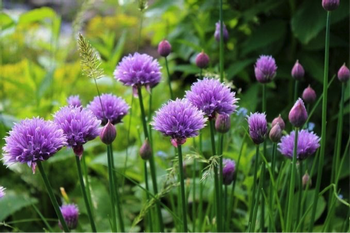Chive
-
Scientific NameAllium schoenoprasum
-
General InformationOnion chives are easy, flavorful perennial herbs with mild onion flavor. The are related to garlic, leek, and bunching onion. Leaves and flowers are edible. Grown in compact clumps, their tubular leaves rise 12 to 20 inches from small bulbs. Flowers attract pollinators. Lovely border. Deer resistant and deter pests.
 Photo: Pixabay
Photo: Pixabay -
When to Plant
Spring is best for planting and dividing.
-
Planting
Seeds: Plant seeds or starts in early spring after last frost date. Save seed of mature chive flower heads, let them dry for a few weeks, then shake out the small black seeds to plant. Sow in clusters for better clumping, with 12 inches between clumps. Cover with one-quarter inch of soil. Keep moist. Plants are slow to mature, and may not be large enough to harvest the first year.
Starts: Save time by buying starts. Plant at soil level, not too deep as roots may rot. Do well in containers or in a garden bed. Divide clumps every two to four years, in spring or fall, and replant in clumps of six to 10 bulbs per clump.
-
Soil Requirements
Okay in most soils, but best in well-draining soil with a pH between 6.0 and 7.0. Find a sunny spot, work in organic matter. Grassy weeds can be difficult to pull out of clumps, so stay on top of weeding.
-
Water Requirements
Water regularly the first year as plants are getting established. Once they are established, keep soil moist but avoid over watering. The soil should be moist down to about six inches.
-
Fertilizing
If a clump begins to thin due to continuous harvesting, fertilize with a light application of an organic vegetable fertilizer blend (5-10-5) in the spring. For containers, use a liquid fertilizer such as fish emulsion at half strength about every four to six weeks. Do not over fertilize as it could weaken the plant.
-
Pollination
Insect pollinated. Attracts bees.
-
Harvesting
Very easy to harvest with scissors. Wait until the leaves are at least six inches tall. Clip them at the base of the plant; it will continue to grow. For flavorful leaves, cut back flowers and use in salads. After the plant flowers, cut back to about three inches tall to force new growth.
-
Storage
Use fresh or cut up and freeze. Stores in the refrigerator up to a week.
-
Good Varieties for Marin
Garlic chives (Allium tuberosum) are different than onion chives. They have flat leaves, garlic flavor, and bear white flowers.
-
Helpful Tips
Plant starts for quicker harvest. Divide the clump every three to four years. Dig up the underground bulbs, replant in groups of four to five bulbs each. In colder weather, plant will go dormant until spring, but will bounce back. Wonderful addition to salads, potatoes, eggs, butter and cream cheese.
-
Common Problems
Black aphids can be a problem; look for them during growth at the base of the plant and along the leaves. Spray with strong stream of water.
-
Pests- Diseases & More
Black aphids.

